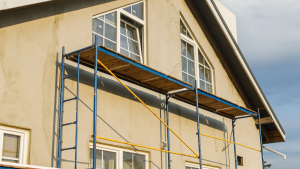When should stucco cracks be repaired? As a homeowner, you may have noticed that your stucco walls are starting to crack. When does repair become necessary?
Cracks in stucco are relatively typical. Anyone with stucco walls would inform you that there are fissures that seem to be their way of life. If you have stucco, you should know how cracks form and when to fix them.
Here is a guide to what causes stucco cracks, how to fix them, and when to do so.
Different kinds of stucco cracks
Stucco walls can develop a variety of crack types. The various causes of them will influence how you fix stucco cracks.
Here are the signs that can help you determine the kind of stucco cracks you have. How to fix cracks in stucco?
Hairline Cracks: These fissures are tiny, often measuring little more than 1/16 inch in width. These are the most typical crack varieties that you’ll encounter. They arise for a variety of reasons. As plaster settles and shifts during construction, these problems are most frequent in new houses. Hairline cracks can sometimes be caused by building work, turning foundations, or the wood drying out.
Foam Trim Cracks: Cracks can occasionally appear in the foam trim used on stucco. When installing the foam trim, fiberglass mesh tape should have been used to prevent cracking, which can be seen here. Once the material has expanded and shrunk, cracking will eventually result.
Spider Cracking: The name comes from how these crevices in your stucco resemble spider webs. If you notice this in your stucco, the base coat needs more time to cure. This might have happened due to the excessive amount of water in the mixture, it dried too quickly, or the temperature needed to be corrected the day it was applied.
Pattern Cracking: On your walls, you might notice cracking that has a pattern. The most typical appearance of your stucco is a grid of horizontal and vertical lines. The installation of the lath had issues, which led to this cracking. It probably needs to be correctly fastened, which will eventually cause more cracks.
Diagonal Cracking: These cracks frequently occur around doors and windows, as their name suggests, are diagonal. These appear due to seismic changes in the foundation, which causes them to shift. You should take care of these cracks first if they are wider than the other cracks in your stucco.
When Should Stucco Cracks Be Fixed
When should your stucco be repaired if you notice cracks in it?
As soon as you can, is the straightforward reply.
You need to fix any cracks as soon as you see them, no matter how minor. Even if it may be tiny right now, it might eventually grow and create more significant problems in the future. You can halt that crack in its tracks if you fill it in at this time.
Along with this, you must make sure your house is secure. If the stucco has cracks, water can seep in and lead to issues with mold and moisture. The sooner you fix that crack, the better, as these are challenging to improve if you don’t catch them in time.
Crack Repair Techniques
The procedure used to fix cracks in your stucco may vary depending on how they occurred.
- If the crack is only a hairline, you can safely fill it in to stop it from spreading.
- If the crack is diagonal or patterned, you will need more effort to repair it or hire professionals.
It’s not very difficult to repair a hairline crack. There are several items that can assist you to fill it in that you may get at your neighborhood hardware shop. If you’re unsure about which one to purchase, consult the personnel there.
DIY
The most popular items are acrylic caulks, which you can use to close up gaps.
- The crack needs to be widened to about a quarter of an inch, and any debris should then be removed with a wire brush.
- Afterward, use a caulk gun and the mixture to fill the crack.
- After giving the caulk 24 hours to cure, paint over it with water-based paint.
When to Consult a Specialist
The lath underneath the stucco must be fixed or replaced if it develops pattern cracks. This implies that the stucco will need to be removed to get entry. It will be necessary to apply fresh stucco over the lath after it has been securely fastened.
Large or diagonal cracks indicate a problem with your home’s foundation. In these situations, you’ll need to hire experts to handle the foundation first; otherwise, you’ll notice more, worsening cracks over time. Engage a specialist to examine your foundation and determine how it can be fixed.
How to Prevent Stucco Cracking in the Future
You should confirm that you can stop further cracks from developing after you have repaired any existing ones in your stucco.
How can you be sure you won’t need to do any more stucco repairs in the future?
Applying fresh stucco will yield the best results because it depends on how it is done.
- To prevent water damage and the ensuing cracks, make sure a strong water-resistant barrier is used in the stucco.
- To prevent cracks as well, the lath must be properly installed.
There are installation techniques that can lessen cracks as well. Inquire about corner beads, casing beads, and control joints from your construction crew. All of this help to lessen stress on the stucco, which lowers the chance of cracking overall.
Conclusion
Any significant issues can be avoided if you exercise caution and closely monitor your stucco. If you fix small cracks as soon as you notice them, they won’t spread and cause more problems. It’s best to fix stucco cracks as soon as you see them.
Call a professional to look at them if they are bigger or more complicated than you anticipated.
By doing this, your stucco will remain in good shape for many years.


